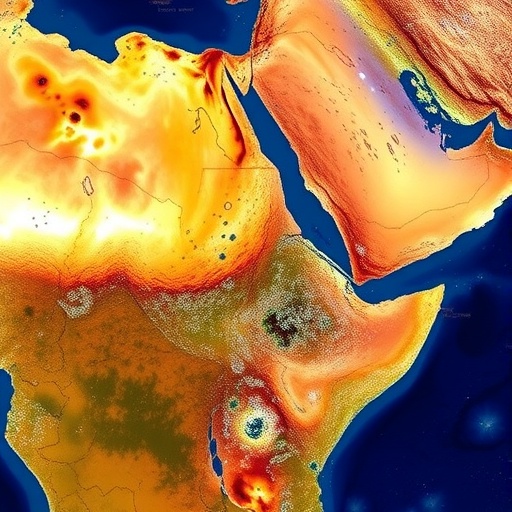In a groundbreaking study recently published in Science Advances, researchers from Brown University are challenging long-standing assumptions about the climatic history of northern Africa during a critical interval in Earth’s past. Covering the period between 3.5 and 2.5 million years ago—a timeframe marked by profound shifts in global temperature and the onset of permanent glaciation in the Northern Hemisphere—this research reveals that rainfall patterns in northwestern Africa remained surprisingly stable. This new evidence significantly revises previously held ideas suggesting widespread aridification across the region during that epoch.
Traditionally, scientists have inferred increased dryness in northern Africa during the Pliocene-Pleistocene transition through dust concentrations found in ocean sediment cores off the West African coast. These dust deposits, interpreted as markers for expanding desert conditions—specifically the Sahara Desert—were thought to reflect diminished summer monsoon activity and reduced precipitation. This paradigm led not only to climatic conclusions but also to evolutionary hypotheses that linked habitat drying to key developments in early hominids, including shifts in bipedal locomotion and foraging strategies.
However, the new research led by Bryce Mitsunaga employed a more direct proxy for ancient rainfall: leaf waxes produced by terrestrial plants. Leaf waxes are lipid compounds synthesized by plants during the summer growing season; critically, these waxes retain the isotopic signature of the water absorbed by the vegetation. Analyzing hydrogen isotope ratios embedded in these waxes, the study offers a direct line of evidence on precipitation patterns. Greater ratios of light hydrogen (protium) to heavy hydrogen (deuterium) within leaf waxes are indicative of sustained or increased rainfall, as heavier isotopes tend to precipitate out earlier during rain events.
Mitsunaga and colleagues examined these chemical signatures within the same sediment cores from which prior dust data had been obtained. Their findings reveal that summer rainfall across northern Africa did not undergo significant reduction during the transition from the Pliocene to Pleistocene. Instead, precipitation regimes remained fundamentally constant despite substantial global climatic cooling and the expansion of Northern Hemisphere ice sheets. This result directly contradicts interpretations that linked increased dustiness to regional drying and raises the intriguing possibility that shifting wind patterns, rather than rainfall variability, were responsible for the observed dust increases.
Such insights carry profound implications for understanding not only paleoclimate dynamics but also broader Earth systems feedbacks. The Pliocene-Pleistocene boundary coincides with atmospheric carbon dioxide levels roughly similar to contemporary concentrations, albeit trending downward at that time. By illuminating the disconnection between global temperature decreases and regional hydrological cycles in northern Africa, the research refines models predicting how present and future climate change might affect precipitation in this climatically sensitive, water-stressed region.
Moreover, these findings invite a reevaluation of hypotheses concerning early human evolution. The previously suggested narrative—that intensifying aridity drove crucial evolutionary adaptations among hominins during this interval—is complicated by evidence indicating the absence of a pronounced drying trend. Species such as Homo habilis and Paranthropus, whose fossil appearances align temporally with this boundary, may have experienced more stable environmental conditions than assumed. This prompts calls for renewed research into the timing and causes of increased aridity in Africa, as well as the ecological pressures shaping our ancestors.
The study’s approach, focusing on robust chemical proxies like leaf wax hydrogen isotopes, demonstrates the importance of multi-faceted analysis in reconstructing Earth’s climatic past. By directly measuring indicators closely tied to biological and hydrological processes, rather than solely relying on indirect sedimentary dust accumulations, scientists can gain a more nuanced understanding of past environmental conditions. This methodology underscores the role of isotopic geochemistry as a powerful tool in paleoclimatology.
Additionally, the research highlights the complexity of interpreting sedimentary records. While increased dust levels in marine cores undeniably reflect changes in continental conditions, this study argues that their cause may stem from atmospheric circulation patterns and wind strength rather than precipitation deficits. If confirmed, such insights could refine interpretations of other dust-based paleoenvironmental reconstructions worldwide.
Funding for this comprehensive study came from both the U.S. National Science Foundation and international partners, including the Natural Environment Research Council and the Royal Society. The interdisciplinary team brought together expertise from Brown University, the University of Southampton, Rice University, and Harvard University, reflecting the collaborative nature of cutting-edge climate science.
Looking forward, these findings suggest that understanding climatic influences on Africa’s hydrological regimes requires integrating isotopic data with models of atmospheric dynamics and vegetation responses. This multi-proxy strategy will enhance predictions of regional climate sensitivity to ongoing global change and help clarify the environmental contexts in which humanity evolved.
In sum, the revelation that northern African rainfall patterns remained fundamentally unchanged during a time of dramatic global cooling challenges existing paradigms and opens exciting new avenues for research. By disentangling the complex interactions between climate, wind, dust, and ecology, scientists are poised to deepen our comprehension of Earth’s history and better anticipate its future.
Subject of Research: Northern African rainfall patterns during the Plio-Pleistocene transition approximately 3.5 to 2.5 million years ago and their relation to global climate change and human evolution.
Article Title: Fundamentally unchanged northwestern African rainfall regimes across the Plio-Pleistocene transition
News Publication Date: 19-Jun-2025
Web References: http://dx.doi.org/10.1126/sciadv.ads3149
References: Mitsunaga, B., Jewell, A., Crocker, A. J., Wilson, P., Buchanan, S., Herbert, T., & Russell, J. (2025). Fundamentally unchanged northwestern African rainfall regimes across the Plio-Pleistocene transition. Science Advances. https://doi.org/10.1126/sciadv.ads3149
Keywords: Climatology, Climate change, Climate data, Precipitation, Rain




